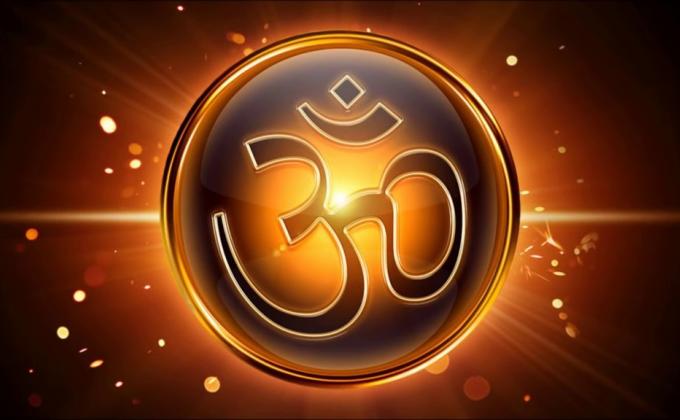
The mantra OM is a mystical sound, pranava, the fundamental principle of the entire manifested world. The unmanifest Absolute begins to manifest itself as the visible universe through the mantra OM. Therefore, it is also called Shabda-brahman, the Absolute, manifested in the form of sound.
For this practice (japa) we sit in front of the altar (if there is one) in the correct posture: legs crossed, spine straight. In our hands we hold a rosary of 108 beads from the sacred rudraksha tree. You need to keep them in such a way that they do not touch the floor, or you can use a special bag.
In the right hand, the rosary is thrown over the middle finger so that the index finger does not participate in the movement of the beads (it is believed that negative energy passes through it).
We concentrate on the level of the chest or between the eyebrows of the saint or our teacher, or the symbol of OM placed on the altar, and we begin to whisper the OM mantra, each time moving one bead with the thumb of our right hand. When we reach a large bead called "Mount Meru", we do not cross it, but unfold the rosary and begin to move the beads in the opposite direction.
Each read circle can be recorded on a special counter for one unit. To perform the practice with the OM mantra in the Laya Yoga tradition, it is necessary to read about 10 thousand circles, that is, to say the OM mantra 1 million times.
The counter can be made from a small wooden stick, on which hang five threads with ten beads on each, except for the last one, which has only one bead. The threads mean the categories: units, tens, hundreds, thousands, and on the last thread there is only one large bead - ten thousand. After reciting one circle of the mantra, we lower one bead down on the first thread (number of units). Etc. Then, having read ten circles, we lower one bead on the second string (tenth rank). Etc. The counting principle is the same as for ordinary office accounts.
The mantra OM can be recited aloud or in a whisper. However, with frequent distraction of the mind to an outsider, the repetition of the mantra by ear is more auspicious.
Usually, the length of the sound is related to the goal that we pursue when reciting OM. If our goal is the result in the manifested world, the emphasis is on "A", if the goal is the astral world, the emphasis is on "U", and accordingly its length is greater. The activation of the "Y" energy strengthens the connection with the subtle body, for example, it gives the experiences of lucid dreams.
The activation of "M" strengthens the connection with the causal body, giving a touch to the experience of emptiness "I".
While repeating the OM mantra, it is recommended to concentrate on the spoken (inner) sound of the OM mantra and the sensations when moving the beads.
In the Laya-ylga tradition, we focus on all three sounds, trying to unite all three states in a single taste (samarasya) of contemplation. All three syllables are present evenly, passing one into the other, and it just sounds like OM.
When performing the practice, special attention is paid to the inner mood (bhava), maintaining divine pride and greatness from contact with the Absolute in the form of the original sound "OM".
The goal of the practice is to develop mindfulness and one-pointedness of consciousness when reciting a mantra.
There are three deviations to be avoided when reciting a mantra:
-
when, while reciting a mantra, the mind wanders, being captured by thoughts, images, experiences (agitation);
-
when the mind is lethargic, passive or drowsy (blurring);
-
when the mantra is recited monotonously, without inspiration, spiritual uplift that arises when reading it.
In the absence of the opportunity to practice the OM mantra in front of the altar, a student of Laya Yoga can recite the OM mantra in motion, paying special attention to maintaining continuous awareness.
In the tradition of Laya Yoga, there is also sadhana using the mantra OM, which is called Guru Yoga based on OM.
